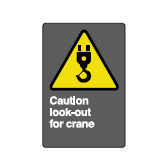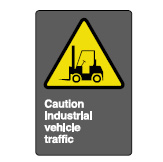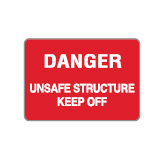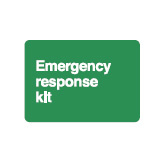Signage guidelines and checklist
Signage Guidelines
Harbour Authority Guidebook, Maritimes and Gulf Regions
Why?
Effective signage allows for improved operational control at harbours, will reduce injuries, property or environmental damage and shows diligence on the part of Harbour Authorities. Small Craft Harbours encourages Harbour Authorities (HA) to develop a signage plan for their harbour(s) and to work at its implementation.
The Plan
The signage plan = "what kind of signs do I need, what will they look like and where will I put them?"
Four Categories:
4 general categories of signs are suggested when assessing your harbour's needs.
- Management: This category of signage is particularly beneficial at the entry of the harbour, as it sets the tone for the use of the facilities and confirms the expectations of the HA. Also, it provides for management identification and the name/telephone numbers of contact groups.
- Operational: This category of signage is particularly beneficial at site-specific service/operational areas and can be used to detail operational practices and rules to be observed. Operational signs may involve some degree of safety, environmental or health concern and should, as required, include the captions for such i.e. DANGER - WARNING - CAUTION - NOTICE.
- Safety: This category of signage is particularly beneficial to advise the harbour public of potential hazards that require their utmost attention in an effort to avoid accidental injury or possible property damage. Safety signs typically fall under the heading of DANGER (hazardous situation that has a high probability of death or severe injury); WARNING (when there is a hazardous situation which has some probability of death or severe injury); CAUTION (hazardous situation that may result in minor or moderate injury) and NOTICE (when you want to indicate a statement of harbour authority policy as the message relates directly or indirectly to the safety of personnel or protection of property).
- Environmental management: This category of signage promotes environmental awareness and identifies practices to be observed in support of the harbour's environmental management plan.
Consult the SIGNAGE CHECKLIST section of this guide for SIGN IDEAS.
Sign Basics
Sign Design
The Canadian Standards Association "CSA" suggests a standard system of colour codes, shapes and symbols in the design of signs.
Sign Types
Symbol / Pictogram signage: Symbol signs typically include pictograms to convey a directive however, text can be added, as required, when a specific graphic is not available or additional clarification is beneficial (combination). A picture is universal in its language.
| Symbol signs | Symbol signs with text | Text signs |
|---|---|---|
 |
 |
 |
| Symbol | Symbol and Text | Text |
|---|---|---|
| Prohibition - A red circle crossed by a red oblique line indicates a prohibition. | Prohibition - Black ink on white background outlined in red. | |
 |
 |
 |
| Mandatory - A solid black circle indicates an order requiring action. | Mandatory - White on black. | |
 |
 |
 |
| Symbol | Symbol and Text | Text |
|---|---|---|
| Caution - A yellow triangle indicates potential harm or risk of injury. | Caution - Black on yellow background. | |
 |
 |
 |
| Danger - A red triangle indicates immediate harm or risk of injury. | Danger - White on red background. | |
 |
 |
 |
| Symbol | Symbol and Text | Text |
|---|---|---|
| Emergency - A green square denotes first aid, health, fire, protection, fire fighting and emergency equipment. | Emergency - White on green background. | |
 |
 |
 |
| General Information - A blue square points out information or directions. | Guidance and Information - White on blue background (or FIP grey background). | |
 |
 |
 |
Side Considerations
The practicality, usefulness and durability of a sign is likely determined by its message, specs and placement.
THE MESSAGE: "A common sense approach - keep it simple, to the point and user friendly."
- Context & necessity
- Brevity & clarity
- Language & familiarity of words
Official Languages: Harbour Authorities are encouraged to use a bilingual format for text signs whenever possible. You will find the French SIGNAGE CHECKLIST for signs on the flip side of the English. Match the index numbers and you will have a complete translated message.
SIGN SPECIFICATIONS: "Impact is key!"
- Design/Presentation: Avoid visual clutter and ensure your sign can be clearly seen from a distance.
- Dimensions: Character size, the lenght of the message and the use of symbols or not determinethe overall size of a sign.
- Material: Standard Aluminium (AL) is recommended for coastal environments.
LOCATION: "It must be visible."
- Traffic flow
- Visibility & viewing range
- Lighting
- Surrounding environment
Small Craft Harbours
Small Craft Harbours Maritimes and Gulf is committed to providing expert advice and support to Harbour Authorities throughout the region. For additional information, please contact us at 1-800-983-6161.
References
Signs and symbols for the workplace - National Standard of Canada CAN/CSA-Z321-96, Canadian Standards Association, March 1996.
Catalogue of signs, Public Works and Government Services Canada, Real Property Services Architectural and Engineering Services, Buildings Directorate.
Federal identity program manual, signage - System Overview and Implementation 4.1, Treasury Board of Canada, December 1992.
Federal identity program manual, Common-use and Operational Signs 4.3, Treasury Board of Canada, March 1990.
Disclaimer
This guidebook is created as a reference tool for Harbour Authority groups within the Maritimes and Gulf Regions. It remains the responsibility of the users of this guide to judge its suitability for their particular needs. The use of signs does not replace the need for other control and accident prevention measures.
Signage Checklist
1. Management Signage
HARBOUR AUTHORITY OF _____________________
"Safeguarding our environment is our goal."
Primary Response Numbers:
Harbour Authority of _____________ (xxx)yyy-zzzz
Small Craft Harbours (DFO): 1-800-983-6161
Area Service Office - location (DFO): 1 800 xxx xxxx
Maritimes Office of Boating Safety (CCG): 1-888-670-0771
Environmental Emergencies (CCG): 1-800-565-1633
Search & Response (CCG): 1-800-565-1582
Fire Department: 911 or yyy-zzzz
RCMP: 911 or yyy-zzzz
Ambulance: 911 or yyy-zzzz
General Rules to be Observed
- Administration and control of this harbour is the responsibility of the Harbour Authority by way of lease with Fisheries and Oceans Canada.
- Responsible environmental practices are required in carrying out your business.
- Accidents, safety issues and other concerns must be reported to the Harbour Authority immediately.
- All posted signs and harbour rules must be strictly adhered to.
- All persons may use the facilities at their own risk.
- User fees apply.
2. Operational Signage
A) Property/Access
- Permit required for entry.
- Authorized persons only.
- All users of the harbour and its facilities shall register with the Harbour Manager.
- All visitors must register with the Harbour Authority.
- Use of facilities by permit only.
- Limited access during peak seasons.
- Harbour access will be limited during peak seasons and outside normal business hours.
- No pedestrian traffic.
- No vehicular traffic.
- Closed area - do not enter.
- Keep off / Keep out.
- No swimming.
- No diving.
- No loitering.
- This property is under the care and control of the Harbour Authority of .. All posted signs and harbour rules must be strictly adhered to.
- User fees apply.
- All persons may use these facilities at their own risk.
- Posted signs and harbour rules must be strictly adhered to - non-compliance can result in expulsion from these premises.
- The Harbour Authority reserves the right to remove any vessel and/or vehicle that endangers or impedes normal harbour activities or operations.
B) Land and Water Traffic
- No parking.
- No parking - vehicles will be towed atowner's expense.
- No parking beyond this point.
- Parking in designated areas only.
- No parking on wharf.
- No unattended vehicles on wharf.
- No vehicles beyond this point.
- Tow away zone.
- Fire Lane - vehicles will be towed at owner's expense.
- Maximum speed 5 km/h.
- Maximum weight 1000 kg.
- Maximum gross vehicle load 3 tons.
- No forklift trucks.
- Look out for forklift trucks.
- Watch out for trucks.
- Avoid the wake. Idle speed only.
- Maximum vessel speed 5km/h.
- Idle speed only inside harbour.
- Signal upon entering harbour.
C) Off-loading/Berthage
- Permit required for all off-loading operations - see Harbour Manager.
- Reserved for off-loading operations.
- Off-loading zone.
- Designated weigh station and buying area.
- Off-loading vehicles at work.
- Off-loading area - no berthage.
- Be alert - hoist/derrick in operation.
- Look out for off-loading activities and traffic.
- Tour boat operations by permit only.
- Reserved for tour boat operations.
- No berthage in this area.
- Designated berthage area.
- Berthage limited to three abreast.
- Keep clear and unobstructed way to shore.
- No person shall obstruct or impede the docking & undocking of vessels in this harbour.
- Berthage fees apply.
- Permit required for all berthage - see Harbour Manager.
- Berth reserved for commercial fishing vessels.
- Pleasure craft berth.
D) Storage/Service areas
- Fish equipment may be stored in designated areas NO EARLIER than 10 days prior to the fish season and shall be removed NO LATER than 5 days after the season.
- Storage of traps in designated areas only.
- Storage of traps on wharf is permitted for the two weeks prior and the two weeks after the fishery.
- Equipment & gear left abandoned on wharf will be removed at the expense of the owner.
- Gear storage permitted in this area.
- Gear storage prohibited in this area.
- No boat storage.
- Vessel hold zone.
- Vessel repair area.
- Boat repair and maintenance activities in designated areas.
- Painting, varnishing or fiberglassing of vessels by permit only - see Harbour Manager.
- Washdown area.
- Cutting & welding operations in designated areas only.
- Cutting & welding by permit only.
- Cutting & welding operations prohibited.
- Do not block launching ramp.
- Authorized use of ramp only.
- Launching fees apply.
- Do not obstruct access to launching ramp.
- Fresh water system.
- Salt water system.
E) Waste and Waste Oil
- All waste to be disposed of in designated receptacles.
- Dumping of fish offal, old bait, garbage or any other refuse is prohibited.
- No littering.
- No dumping.
- Dangerous waste oil disposal practices warrants eviction from wharf.
- Sound waste oil disposal practices are required.
- Key-lock waste oil disposal system-see Harbour Manager.
- Keep tank free of debris other than waste oil.
- Keep area tidy.
- Keep funnel clear - oil filters, rags and containers must be removed from tank area.
F) Fuelling
- Permit required for all fuelling operations.
- Designated fuelling area.
- Fuelling only. No berthage in this area.
- Fuel storage prohibited.
- Fuel trucks prohibited.
- Fuelling by truck only.
- Fuelling prohibited.
- Dangerous fuelling practices could result in expulsion from wharf.
- Fuel system emergency shut off switch.
- Underground fuel line - no excavation.
G) Construction
- Construction zone. Unauthorized personnel keep out.
- Construction activity, traffic and machinery in use - keep away.
- Construction by permit only - see Harbour Manager.
- Danger underground cable - no excavation.
- Construction underway - keep away.
H) Other
- Harbour users shall not take any action or perform any operation that poses a threat to human life, endangers the structural integrity of the wharf, or impairs the marine ecosystem, harbour environment or fish habitat.
- The Harbour Authority has the authority to take any and all action as deemed necessary to preserve the integrity of the harbour and to provide for safe and accessible harbour facilities.
- Failure to abide by harbour rules could result in harbour access/services being denied and/or court action.
- Harbour is monitored by a security system - reasonable use of facilities is expected
3. Safety Signage
I) Safety (label below signs under the heading DANGER, WARNING, CAUTION or NOTICE depending on the degree of risk).
- Wharf unsafe.
- Wharf unsafe - vehicle and pedestrian traffic prohibited.
- Structure unsafe - keep off.
- Accidents, safety issues and other concerns must be reported to the Harbour Authority immediately - see Harbour Manager.
- Wharf unsafe - Barricaded zone - vehicle and pedestrian traffic prohibited.
4. Environmental Management
J) Environmental Management
- Emergency situations, spills, fires and accidents must be reported to the Harbour Manager.
- Handling, storage and disposal of hazardous material is prohibited.
- Responsible environmental practices are required in carrying out your business.
- Removal of sand from beach is strictly prohibited.
- Date modified: